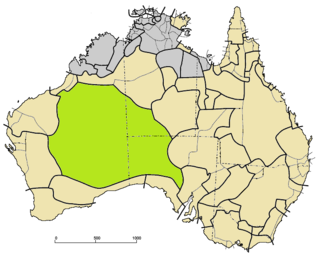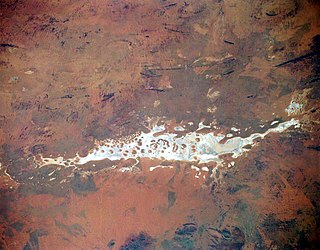
The Warlpiri are a group of Indigenous Australians, many of whom speak the Warlpiri language. There are 5,000–6,000 Warlpiri, living mostly in a few towns and settlements scattered through their traditional land in Australia's Northern Territory, north and west of Alice Springs. About 3,000 still speak the Warlpiri language. The word "Warlpiri" has also been romanised as Walpiri, Walbiri, Elpira, Ilpara and Wailbri.
The Luritja dialect is the dialect of the Luritja people and an Indigenous Australian Western Desert Language.
There are several hundred Indigenous peoples of Australia; many are groupings that existed before the British colonisation of Australia in 1788. Within each country, people lived in clan groups: extended families defined by various forms of Australian Aboriginal kinship. Inter-clan contact was common, as was inter-country contact, but there were strict protocols around this contact.

The Western Desert language, or Wati, is a dialect cluster of Australian Aboriginal languages in the Pama–Nyungan family.
The Pintupi are an Australian Aboriginal group who are part of the Western Desert cultural group and whose homeland is in the area west of Lake MacDonald and Lake Mackay in Western Australia. These people moved into the Aboriginal communities of Papunya and Haasts Bluff in the west of the Northern Territory in the 1940s–1980s. The last Pintupi to leave their traditional lifestyle in the desert, in 1984, are a group known as the Pintupi Nine, also sometimes called the "lost tribe".
The Western Desert cultural bloc or just Western Desert is a cultural region in central Australia covering about 600,000 square kilometres (230,000 sq mi), including the Gibson Desert, the Great Victoria Desert, the Great Sandy and Little Sandy Deserts in the Northern Territory, South Australia and Western Australia. The Western Desert cultural bloc can be said to stretch from the Nullarbor in the south to the Kimberley in the north, and from the Percival Lakes in the west through to the Pintupi lands in the Northern Territory.

The Amadeus Basin is a large (~170,000 km²) intracratonic sedimentary basin in central Australia, lying mostly within the southern Northern Territory, but extending into the state of Western Australia.
The Ngalia Basin is a small intracratonic sedimentary basin in central Australia, lying within the southern Northern Territory. Deposition of locally up to about six km of marine and non-marine sedimentary rocks took place from the Neoproterozoic to the late Paleozoic. Along with other nearby sedimentary basins of similar age, the Ngalia Basin is believed to have once been part of the hypothetical Centralian Superbasin, that was fragmented during episodes of tectonic activity.
The Mantjintjarra and Ngalia are Australian Aboriginal peoples belonging to the Western Desert cultural bloc. They are seeking recognition of their inherent land rights through the Australian Federal Court native title claim process. In March 2009 the Mantjintjarra Ngalia claim came a step closer to recognition after passing the stringent registration test of the Native Title Act.
Kado Muir is an Australian Aboriginal artist, anthropologist and Indigenous rights activist. He is a leader of the Ngalia tribe and an applicant on the Mantjintjarra Ngalia peoples native title claim.
Louisa Lawson Napaljarri (Pupiya) was a Warlpiri-speaking Indigenous artist from Australia's Western Desert region. Louisa commenced painting at Lajamanu, Northern Territory in 1986. Her work is held by the National Gallery of Victoria.
Helen Nelson Napaljarri, also known as Helen White Napajarri or Helen Spencer Napaljarri, is a Walpiri-speaking Indigenous artist from Australia's Western Desert region. A literacy worker in Yuendumu, Northern Territory, Helen began painting with Warlukurlangu Artists in the 1980s. Her paintings are held by the Art Gallery of South Australia and South Australian Museum. She has contributed to several bilingual language books in Walpiri and English.
Ngalia, Ngaliya or Ngalea may be,
The Mangala are an Indigenous Australian people of Western Australia. The Mangala people traditionally lived in the north-western area of the Great Sandy Desert, west of the Karajarri people, east of the Walmajarri, with the Juwaliny and Yulparija to the south. At present many Mangala people live in Jarlmadangah and Bidyadanga.
The Gugadja, also written Kukatja, are an indigenous Australian people of Western Australia who speak the Kukatja language.
The Ngarti, also spelled Ngardi, are an indigenous Australian people of the Northern Territory and Western Australia.
The Mandjindja or Mantjintjarra are an indigenous Australian people of Western Australia.
The Ngalea or Ngalia were an indigenous Australian people of the Western Desert cultural bloc resident in land extending from Western Australia to the west of South Australia. They are not to be confused with the Ngalia of the Northern Territory.
The Kokatha, also known as the Kokatha Mula, are an indigenous Australian people of the state of South Australia. They speak the Kokatha language, close to or a dialect of the Western Desert language.
The Ngaliya (Ngalia) are an indigenous Australian people of the Northern Territory who speak a dialect of the Warlpiri language. They are not to be confused with the Ngalia of the Western Desert.









